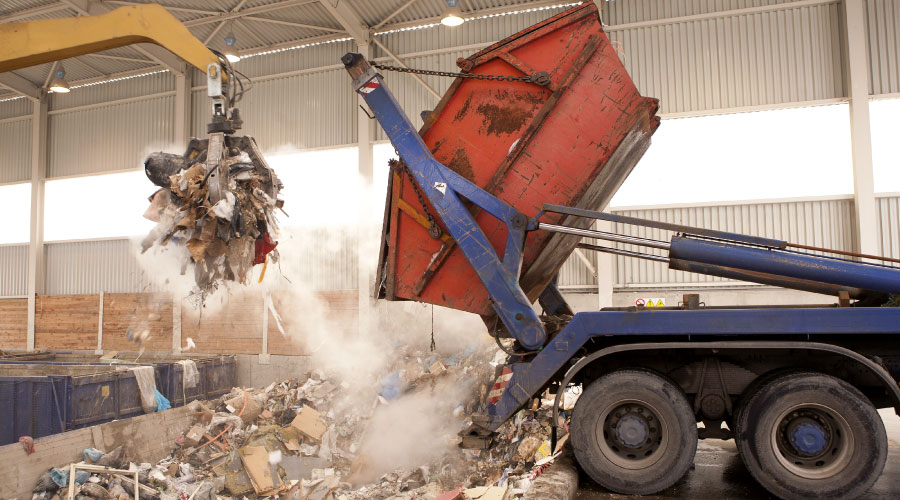How to Reduce Waste on Construction Projects
A crucial environmental strategy, reducing construction waste takes time and patience for facility managers. Here are some best practices.
By Greg Zimmerman, senior contributing editor
Whether a project is a ground-up brand-new building or just a couple-weeks renovation project of a particular part of the office, focusing on reducing waste and increasing recycling during the construction process is taking on increasing importance. The environmental benefits of reducing construction waste are manifold. For this reason, many green building rating systems like LEED and others award a successful approach to reducing construction waste. But reducing construction waste isn’t always simple. Facility managers who are running construction projects must have detailed plans for what to do with waste generated during construction.
FacilitiesNet recently talked with Patricia Lloyd, LEED Fellow, WELL Accredited Professional, LFA, director of sustainability at general contractor Leopardo Companies about best practices and expected benefits of reducing waste on construction projects.
FacilitiesNet: How can reducing waste during construction be a cost reduction strategy rather than something that adds cost to a project?
Lloyd: The answer to this question varies by region. We have areas of the country that we build in that have zero premium for significant waste diversion and other areas of the country where recycling options are limited, non-existent, or extremely expensive. There are also variables like commingled waste streams and single sorts that determine the price. How far do you have to truck the recyclable so that it can avoid the landfill? Is avoiding a tipping fee beneficial if you are paying someone to decommission the space? Does the hauler charge to provide reporting of diversion and dump tickets? There are a lot of considerations that need to happen to achieve zero waste.
Zero waste isn’t about cost minimization – it is about reducing the environmental impact of the construction project. We have one earth, and landfilled materials are buried in that earth. All the materials we build out of are mined or harvested from earth. In fact, the construction industry is the largest user of natural resources, with 101 billion tons of global material extracted annually. When we landfill them all of the energy that was spent to create that building material is lost, buried. When we salvage usable materials for reuse or recycle materials from construction and demolition — we are capturing and paying forward that energy use and relieving the environmental burden of extraction of virgin materials.
If every sustainable activity is looked at through the lens of cost and ROI, it is unlikely that we will ever get to zero waste. At this time in most areas, it is still cheaper to tip a box into the landfill than it is recycle. There are major changes that need to happen in infrastructure that will make it cost effective. For example, there are one or two American cities that own their own landfills, and they are pushing the tipping fees up to make landfilling not so compelling. Many other cities across the nation have construction and demolition waste ordinances, prescribing a specific percentage of waste diverted from the landfill, and more and more cities are putting in place deconstruction ordinances to try to keep usable materials in the reuse stream, which is the highest and best use.
FacilitiesNet: How do third-party rating systems reward teams for zero waste construction projects?
Lloyd: TRUE Zero Waste is a third-party rating system that organizations can use to achieve their zero waste goals. There is currently a pilot program for construction projects that has been tested by several construction firms nationally. This pilot program is the only third-party green building program that is solely focused on construction and demolition waste. I am very interested in stimulating demand in these programs and looking for a client that wants us to execute a TRUE Zero Waste Construction project for them, and then pursue TRUE Zero Waste certification for their operations.
Since its inception, LEED has always had a construction waste management credit in the Materials and Resources category. This credit has changed significantly through the years as the applicability of different strategies and regions was addressed. The waste credits are fundamentally very important to the LEED rating system as they address the construction process and provide an outlet where the contractor can take ownership and succeed. It also created a pathway for certified recycling facilities.
Another rating system with a strong focus on waste reduction is the Living Building Challenge from the International Living Future Institute. In this rating system the project must achieve net positive waste during design, construction, and operations, and have an end-of-life plan for materials.
These programs give credence to the fact that tremendous amounts of waste are created, and wasted during the construction and demolition processes. According to the EPA’s last published study in 2018, Construction and Demolition Debris (CD&D) was more than double the waste stream in landfills than municipal solid waste was. Much of this consists of heavies like asphalt and concrete, which are typically recyclable.
FacilitiesNet: How can project teams ensure that materials designated for recycling and thus diverted from waste streams are actually recycled and diverted?
Lloyd: We must be diligent and aware and request the appropriate documentation to validate that. RCI certified facilities are one way to validate that the items are recycled and to also validate the ADC rate (alternative daily cover). Some waste haulers count ADC as recycled, but in fact it is used to cover landfill cells at the end of the day, so though it is of use, it is still landfilled. LEED and TRUE do not acknowledge ADC as recyclable. Other parts of the country, like the Bay Area, have created criteria that local haulers must meet to be used on projects. One way we validate with new haulers is to request who the receiving entities are that the recycled commodities are going to, in addition to monthly LEED reporting, and dump tickets on certain projects. When donating usable materials to a non-profit, the validation comes in the form of a receipt from their receiving department that we share with our clients so they can receive the tax benefit.
FacilitiesNet: Can you describe some of your successes with waste reduction on construction projects at Leopardo? What are some best practices and tips you'd give to other managers hoping to achieve similar results?
Lloyd: I have been fortunate to have learned so much along this journey through my involvement with serving on the USGBC Materials and Resources Technical Advisory Group a few years ago, working with Building Green on the Contractors Commitment to Sustainability, and through my graduate capstone project becoming involved with a nationwide network of building materials reuse advocates.
All along the way I have been bringing that knowledge back to Leopardo. Leopardo has long been pursuing reduced waste from the landfill on both our corporate and jobsite operations. In 2016 we wrote a corporate waste plan with a diversion goal to apply to our projects and we calculate annually the diversion rate and tonnage of those we have reporting on. We started tracking donated items about three years ago as we realized that there are often usable materials that won’t achieve their best and highest use if recycled or landfilled.
In late 2022 we launched our corporate ESG program, and under the environmental pillar we have four goals that are aimed at reducing the environmental footprint of our jobsites — one of those goals is directly related to salvaging of usable materials and waste reduction. Through that program we have had a number of projects over the last year participate in waste reduction strategies like utilizing manufacturer take back programs during demolition, diverting usable materials from the waste stream to reuse, and diverting 75 percent or more from the landfill.
Greg Zimmerman is senior contributor editor for the facility group, which including FacilitiesNet.com and Building Operating Management magazine. He has more than 19 years’ experience writing about facility issues.
Related Topics:












